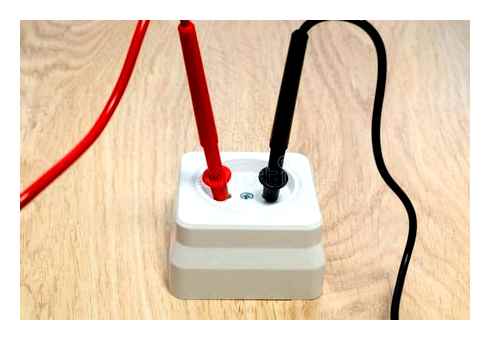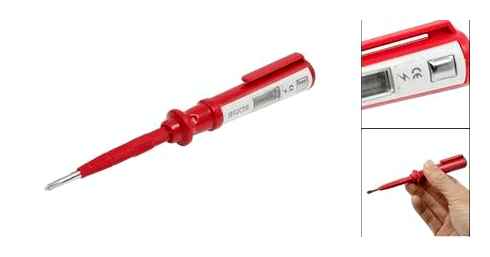What the screwdriver indicator is for. Checking an appliance for serviceability
How to check the indicator screwdriver
Sometimes there is a need for certain electrical work in the home. And if you have an indicator screwdriver in the house, it is easy to know, for example, the presence of the phase. When considering devices, the principle of operation is taken into account, it is important to understand the varieties. Modern products are easy to use, but it is necessary to know the rules.
The indicator screwdriver is a tool that can be used to detect phase voltage. The multifunctional device allows you to fix the activity in a certain area. Using a device, it is easy to detect the neutral or a dangerous conductor that is energized.
To use any device successfully, you need to understand how it works. The same applies to the indicator screwdriver. Knowing how it works, at least in general terms, allows you to use it effectively and avoid mistakes. It will also allow you to do without a more complicated and expensive multimeter.
How to Install an Electric Vehicle Charger Receptacle
Let’s look at a few basic types of indicator screwdrivers, it will further allow us to choose the more appropriate option.
Conventional voltage tester with a neon bulb. The principle of the indicator screwdriver is as follows. The electric current from the surface of the conductor comes to the screwdriver sting, then through a resistor of at least 0.5 mOhm (to limit the current) goes to the contact of the neon lamp. The second contact of the light bulb circuit closes in on the person through the contact on the screwdriver handle. In this type of screwdriver, capacitance and resistance of the human body are included in the light bulb circuit. That is you touch the stinger to the wire and your finger to the contact, if there is voltage, you can see the neon light glow. No human contact. the lamp does not glow. The disadvantage of this type of screwdriver is the high voltage indication threshold, starting at 60V. They are only good for determining whether voltage and phase are present. It is not possible to detect open circuits with this tool.
Screwdrivers with an LED indicator. Same principle as a neon bulb screwdriver. The main difference is the lower voltage indication threshold, the LED will glow from voltages less than 60V.
Screwdrivers with LED indicator and self-contained power supply (batteries). This is the multi-functional indicator screwdriver. In addition to the power supply, this type of screwdriver also includes a transistor, usually a bipolar. It has five functions:
- phase detector;
- Detects circuit breakage;
- allows you to find the location of damage in a conductor;
- Detects polarity of DC sources;
- the ability to detect the presence of voltage in a non-contact way to find the location of the wiring (this effect is based on the magnitude of the magnetic field).
Some versions of these screwdrivers are also able to detect microwave radiation, such as in microwave ovens.
Electronic display screwdriver. Can be in two versions: with or without an LCD display. Equipped with an audible signal of voltage. In fact, this is a simplified and very handy multimeter. LCD display allows you to determine not only the presence of voltage but its magnitude (from 12V to 220V). The operating principle is broadly similar to previous analogues of indicator screwdrivers. The scheme of such a device will not be given, I doubt that if such a screwdriver breaks you will look for faulty elements at the radio market, and change them. Time spent repairing it is simply not worth the cost of a new tool.
Types of indicators
Detectors are divided into several different types. They are classified according to the principle of action, the mechanism used to alert the user when wires are detected, and so on. Each device has its advantages and disadvantages.
- Electrostatic indicator of hidden wiring is used to search for the electric field formed by voltage on wires. From the advantages we will highlight the simplicity of the circuit and the ability to detect current over long distances. Disadvantages. can only work in a dry environment, as well as the presence of voltage in the network to register the wiring.
- Electromagnetic device registers the electromagnetic field created by current moving through the wires. The detector scheme is as simple as possible, and allows a high degree of accuracy. The disadvantage is similar to the electrostatic counterpart: wiring must be live, and the connected load. not less than 1 kW.
- Inductive indicator. in fact, an ordinary metal detector. Such a device creates an electromagnetic field on its own, and then records its changes. The main advantage is that there is no need for power. Of the disadvantages. a complicated circuit and the possibility of false positives, since the detector will fix any metal products.
- Combined indicator. factory models, which are based on different principles of operation. On the background of high accuracy, sensitivity and efficiency the only disadvantage is the high cost.
Electrostatic devices
Detectors of this type register the presence of electromagnetic field emanating from the wires to which the voltage is connected. This is a fairly simple device, which is not difficult to assemble with your own hands (the scheme of the device will be given in the final section). Note that almost all inexpensive detectors work on this principle.
Detector E121
Features of electrostatic type detectors:
- Given that the device reacts to electromagnetic radiation, the detection of wiring requires that it is not de-energized;
- when working with the detector must select the optimal level of sensitivity. If it is low, it can be difficult to detect deep wiring, at the maximum level there is a high probability of false alarms;
- Damp walls or the presence of metal structures make the search for wiring almost impossible.
Considering their low price, simplicity and efficiency (with the exception of a few restrictions), electrostatic devices are popular even among professional electricians.
Electromagnetic detectors
This type of alarms allows you to detect electromagnetic excitation coming from the wires if a load is connected. Electromagnetic wirefinders are much more accurate and efficient than electrostatic ones.
Electromagnetic Alarm
These devices have a characteristic feature, which lies in the fact that for a guaranteed definition of the route of wiring it is necessary to connect the load, the power of which is not less than one kilowatt, which in most cases does not cause difficulties. For example, you can do this by connecting an electric kettle to the corresponding power line (don’t forget to fill it with water).
Metal detectors
In those cases where you can not connect voltage to the wiring or the load to it, use metal detectors. The principle of operation of these devices is based on the fact that metal, falling into an electromagnetic field, causes disturbances in it, which are recorded by the device.

The PMD 7 from Bosch
The peculiarities of this class of devices are that they react to any metal in the walls. That is, in addition to the wiring, the detectors will work when detecting fittings, screws, nails, etc.д.
Passive detectors (radiation receivers)
Such wire detectors react to the electric or magnetic field of the wire. They are insensitive to de-energized wiring. It is also useless to search with their help for wiring with direct current.
Combined finders
Devices of this type are multifunctional devices. multidetectors. They can combine several principles of the search for buried wiring in the wall, which significantly expands the scope of application and increases efficiency.
As an example, we can take the model TS-75, shown in the photo below. This device combines the functions of a metal detector and electrostatic detector.
Types of indicator screwdrivers
There are three varieties of the considered tools:
- Conventional or passive, which design was discussed above
- With built-in self-contained power supply, which gained wide popularity
- Electronic
The capabilities of the first two types of devices are already known. The electronic version of indicator screwdrivers differs from the previous variants in that they are equipped with a built-in LCD display. This is reflected in the cost of the product, which is twice as high as its battery-powered counterpart. Electronic testers are also called multifunctional testers. It performs similar functions as the above products, as well
- Indicates the value of the voltage in the range from 12V to 220V
- Indicates the presence of a neutral conductor
- Determines the strength of the current in the circuit
- Detects the value of active power
- Have a smaller error when locating hidden wiring, as well as locations of damage
With this voltage indicator you can find electrical faults quickly and efficiently. Especially valued in the tool ability to detect hidden wiring, which speeds up the process of repairing a broken cable. Additional functions of electronic indicators include the presence of sound and light alarms, as well as mini-phonics.
That’s interesting! A disadvantage of electronic devices is their high cost. That’s why they are not widely used among electricians. The universal device under consideration is an analogue of a multimeter.
How do I carry out a serviceability test with the GasTest delta3?. Leakage measurement
If you need to find the voltage value of a circuit or test a wire, a screwdriver with an indicator can replace a multimeter. But it’s important to understand the difference between this tool and a multimeter: an electronic screwdriver shows the voltage being measured, as opposed to a multimeter, which shows the corresponding value.
Non-contact voltage indicators
Non-contact voltage indicators by their configuration are also a kind of screwdriver. They use a more powerful power source than batteries of previous models. A distinctive feature is a plastic stinger instead of a metal stylus.
What kind of tool an electrician should have. What are the general requirements for wiring tools
Potential difference is detected without contact with live parts, only by induced electromagnetic fields. This model is not a measuring model and only allows the detection of potential differences. Several operating modes with corresponding sensitivities are available for different voltage sources.
When performing measurements, an active non-contact screwdriver may not make direct contact with the object. The signals are signaled by flashing LEDs, with some models being supplemented by an audible alarm. These devices are mainly used to locate live wires laid in conduits or inside walls.

Another function of the proximity tester is to find any metal objects in the wall. It can be old unused wires, fittings and other parts. However, due to the low sensitivity of such screwdrivers, in most cases inaccurate results are obtained.
How to use an indicator screwdriver
When working with the power grid, it is necessary to observe safety rules and to know how to use the tester-indicator correctly. The main point. disconnection of packet switches in electrical circuits during disassembly of switches, sockets, etc. You should also make sure that the instrument is working properly, because the accuracy of the readings and the safety of the user (craftsman) depends on its technical condition. The device should have a complete body. no chips, cracks, etc. If there is minimal damage, the device is replaced, because the consequences of an electric shock may be irreversible.
The working condition of the tester is checked by shorting the circuit by hand (putting your fingers on the probe and the “heel” of the probe at the same time). Lack of glow happens in two cases:
- if the device is out of order and needs to be replaced. Repair is not feasible, since the effort involved will be much more than the cost of a new tool.
- Dead batteries that need to be replaced with new ones. When installing them, pay attention to the polarity, otherwise the device will not function.
Faulty wiring
It happens that when you test an outlet, the probe shows voltage on two wires at once. This result occurs if there is a zero break and the phase has gone on in the closed circuit. Possible causes:
- Breakage of a neutral wire in the switchboard entrance. The problem is solved quickly. disconnect your lead in the switchboard, wipe it clean and reconnect it.
- Disconnected automatic unit (plug).
- Weak contact, excessive load in the apartment junction box.
- Damage to electrical wiring by rodents, repair work.
Selection criteria
When choosing a tester, consider such characteristics as:
- The shape of the stinger. the stinger of the device should be flat and durable. This will not only measure voltage, but also unscrew various screws on terminals, wiring boxes;
- Material. the body of the tester must be made of shock resistant plastic;
- Ease of use. the device should lie well in the hand, have a clip to attach it to the lapel of the ;
- Functionality. the most convenient models have additional functions such as “probe”, the determination of the value of the measured voltage;
- Notification of the presence of voltage. with a sound from a built-in speaker or activation of a small LED, neon light bulb;
- The presence of a display. a small monochrome display allows you to display the voltage value;
- . Experienced electricians use more expensive and reliable testers
- Manufacturer. the most popular and reliable products are made by such brands as Yato, Wortex, Stanley, IEK, Fluke.
Also, when choosing a tester, you should consider reviews of this or that model on the Internet.
Working with an indicator screwdriver. 6 ways to use.
This article is about a simple battery-operated indicator screwdriver, which has a simple circuit based on a field-effect transistor.

It is the use of a polovic, expands the possibilities of using this indicator compared to simple screwdrivers containing only a neon bulb.
The first thing I would like to pay attention to is the sting of the screwdriver. Most of the models are not designed to do the actual twisting and unscrewing.
This is their extra feature. So always use a regular screwdriver with a hardened tip or an appropriate bit for this kind of work, not the indicator versions.
The most useful feature of this model is the LED light that turns on when you touch the tip and the contact at the opposite end.
Actually, it’s a continuity check indicator. How it can be used in the home will be discussed below.
Be careful, if the indicator will be phoned all over the wall, you may have a leak somewhere and short-circuited.
To find a phase in an outlet or cable, you need to touch the contact to be tested with a screwdriver. Do not touch the metal stud on the end of the indicator!
If you do this, the indicator will light up equally in both sockets of the outlet, where the phase and the zero to make out will not be possible.
True, the sensitivity of such a screwdriver can be a disadvantage as well as an advantage. For example, in a three-phase 380V network, when phases are close together, the tool can be affected by induced voltage.

So for simple no-voltage detection, a batteryless indicator with a neon bulb, is still more reliable.
It is better to use this device precisely because of its additional features.
The possibilities of a simple indicator screwdriver can be significantly expanded, and many people simply do not know that in addition to the usual check the presence or absence of voltage, this device can perform many tasks and look for various faults.
Here’s how you can use it in practice.
It is possible to do this test directly in the store without having anything else to hand but a screwdriver. Take an ordinary light bulb, grab the metal base with one hand and with the finger of the other hand touch the contact at the top of the screwdriver.
After that, you touch the center contact on the bulb with the stinger.
If the lamp is functional, the LED lights up.
But this test doesn’t give 100% assurance, because if the lamp is depressurized, it will not light up, even if the circuit is intact.
You can also easily check if the heating element is working or broken. You don’t even need to remove it from the equipment.
Easy access to contacts is sufficient. Before doing so, all foreign wires connected to them must be discarded.
Checking is very simple and straightforward. Use one hand to touch one of the pins of the heating element and the tip of your screwdriver to touch the other. The finger of your other hand should again be on the metal stud of the probe.
If the light does not go on, then the heating element inside the tube is broken and there is a heating coil inside it.
All heating elements can be checked in this way. For example, the boilermaker is checked directly on the plug itself, you don’t even need to disassemble anything.
In order to mount the switch correctly when repairing, that is:
You can also use a probe and test the contacts.
Disassemble the switch beforehand. The pins are usually covered so you can’t reach them with your hands.
Take any metal object, such as a paper clip or a nail, and touch one of the pins. It does not matter which one. The wire is either on the top or on the bottom.
The indicator screwdriver is put on a different contact. The light-emitting diode is off when the switch is turned off, and vice versa. You leave the switch on, assemble it and then mount it on the wall.
If you are doing major renovations in your apartment, you have probably encountered a situation where, after removing the old plaster, you suddenly discover some previously unknown wire.